six、CPU energy consumption and energy efficiency test:Snapdragon 870 and Snapdragon 888 reach the same goal by different routes
We use PrefDog and Geekbench to collect CPU power consumption data of mobile phones and calculate CPU energy efficiency ratio,The specific method is as follows:The settings of the Redmi K40 and Redmi K40 Pro participating in the test are unified to the lowest brightness,Turn on airplane mode,Use the same version of Geekbench。
Use Prefdog to test power consumption first,Close all the background of the phone first,lowest brightness,WiFi only,Test the no-load power consumption of the mobile phone at this time,The specific method is to select the mobile phone desktop as the test software,Leave your phone still and do nothing,Get a power consumption curve and average power consumption value,record the value。
Then use Geekbench to run the scores separately,Collect average power consumption data and subtract no-load data during running minutes,Get the power consumption of the mobile phone processor。combined test results,Finally got the frame rate、Power consumption,And the energy consumption ratio data calculated from it。
In order to more intuitively feel the difference between the two,Our direct test results and energy efficiency ratio calculation results are summarized in the following table,for reference。
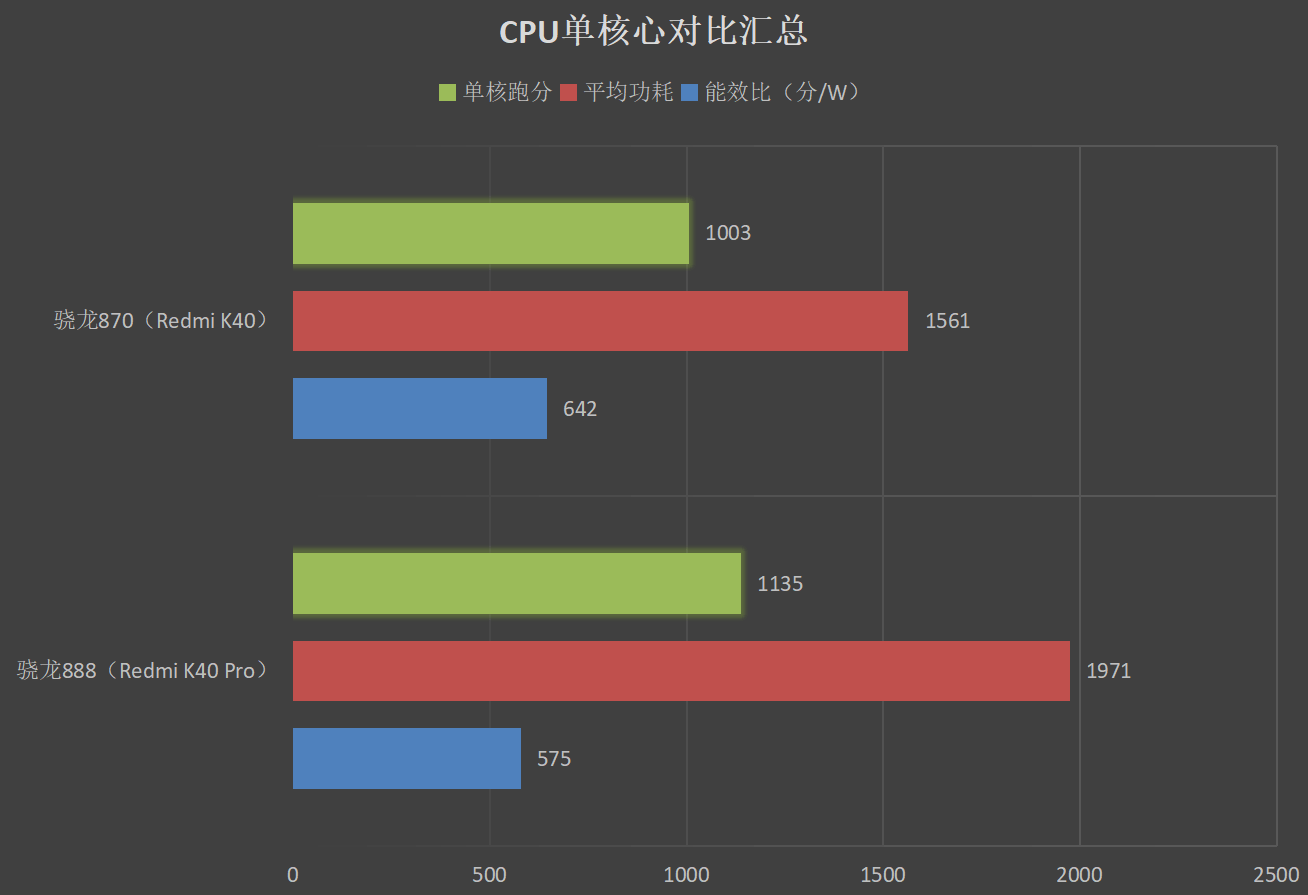

can be found from,Whether the CPU is single-core or multi-core,The Snapdragon 888 on the Redmi K40 Pro can provide stronger performance than the Snapdragon 870 on the Redmi K40,Of course, the power consumption will also increase,However, the energy efficiency ratio of the two is not much different (10% difference between single cores),Multi-core gap 1%)。
thus,Combined with our previous special test results on Snapdragon 888 VS Snapdragon 865,basically can be judged,Under Geekbench's extreme test scenario,Whether it is Snapdragon 870 or Snapdragon 888,None of their CPU peak performance gains are linear compared to the Snapdragon 865,The increase in power consumption will outweigh the increase in performance。
seven、GPU energy consumption and energy efficiency test:Xiaolong 870 is slightly better
We use PrefDog and GFXbench to collect GPU power consumption data of mobile phones and calculate GPU energy efficiency ratio,The specific method is as follows:The settings of the two mobile phones participating in the test are unified to the lowest brightness,Turn on airplane mode,Use the same version of GFXbench。
Use Prefdog to test power consumption first,lowest brightness,Only turn on WiFi and essential tools,Test the no-load power consumption of the mobile phone at this time,The specific method is to select the mobile phone desktop as the test software,Leave your phone still and do nothing,Get a power consumption curve and average power consumption value,record the value。
Then use GFXBench to perform a single off-screen running score,Collect average power consumption data and subtract no-load data during running minutes,Get the power consumption of the mobile phone processor。Due to the cumbersome details of the specific testing process,Next, directly summarize our test results in the following table for reference。
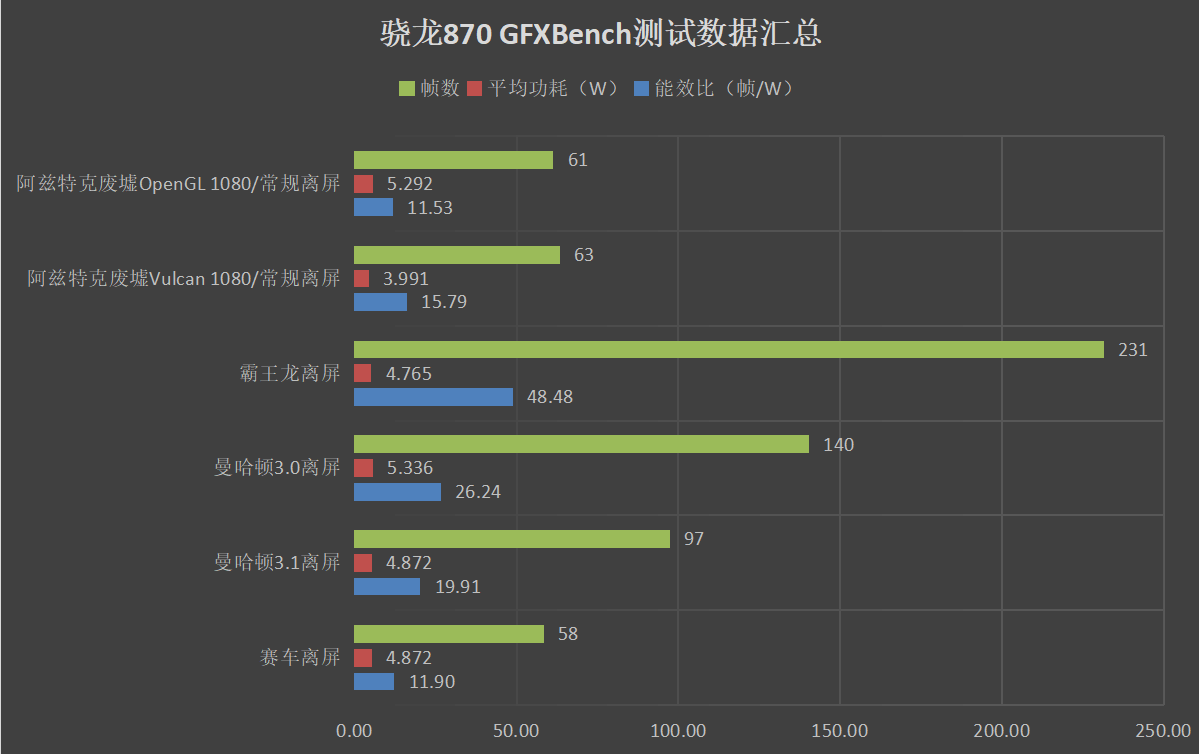
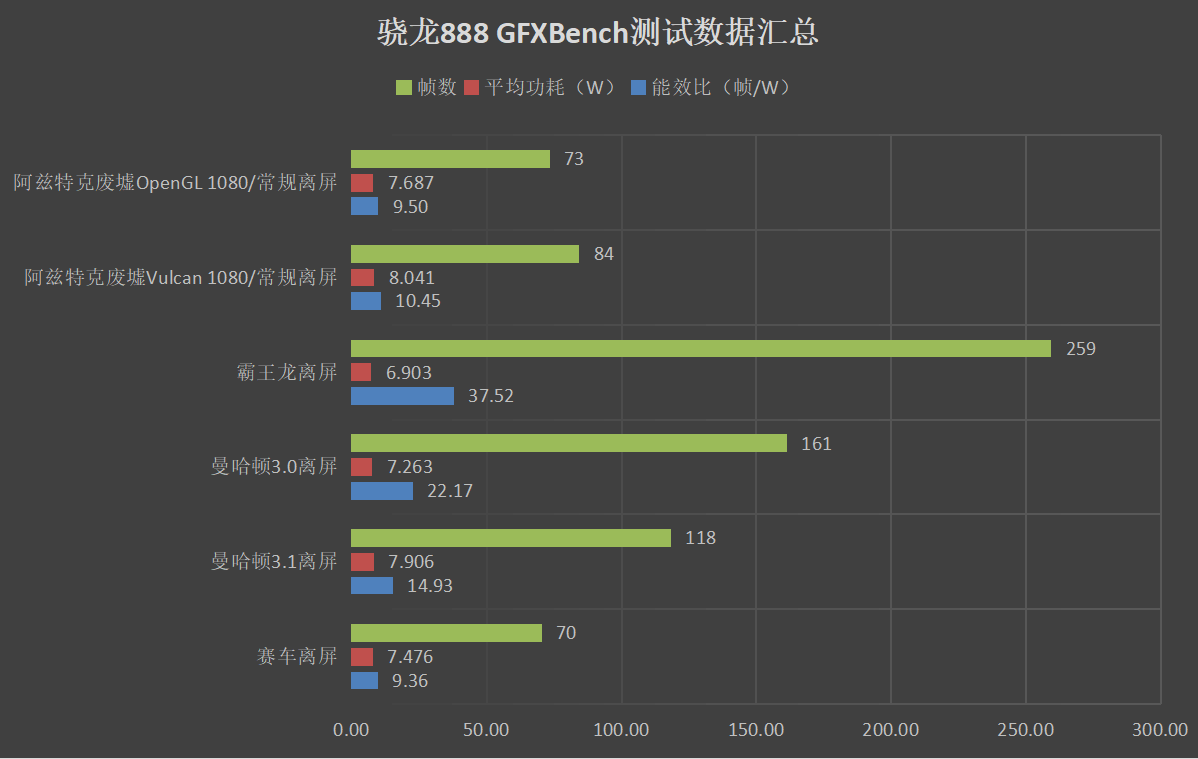
It can be seen more intuitively,Snapdragon 888 will increase power consumption while providing stronger GPU performance,Compared with the Snapdragon 870 equipped on the Redmi K40, the energy efficiency ratio of each test sub-item will be reduced (about 20% gap),The difference in energy efficiency ratio between the two is really not that big。
Combined with our previous Hengping comments on Snapdragon 865 and Snapdragon 888,It can be basically concluded that whether it is Snapdragon 870 or Snapdragon 888,Compared with the previous Snapdragon 865 GPU peak performance improvement,are not linear。
certainly,The above tests are more aimed at the extreme full load condition,The energy consumption in daily use is simply not so high。
eight、For body temperature、storage、AnTuTu's series of tests
——Temperature measurement
The test was carried out at a room temperature of about 21°C。Specifically, the AnTuTu running score test is carried out in a constant temperature indoor environment.,Use a temperature measuring gun to measure the maximum temperature of the body before and after running the score。
The highest temperature of the Redmi K40 body before running the score is 27.4°C,After running the score rose to 34.8°C。
The maximum temperature of the Redmi K40 Pro body before running the score was 28.9°C,After running the score rose to 39.5°C。

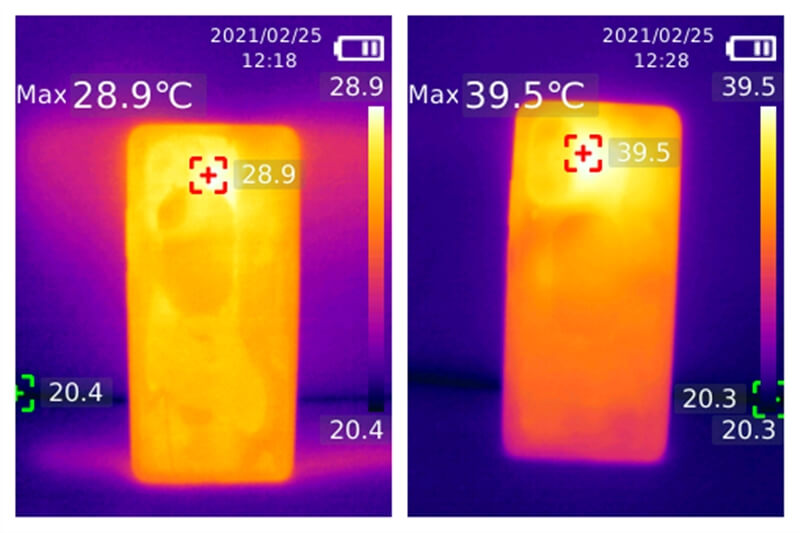
--storage
The entire Redmi K40 series is equipped with dual-channel UFS 3.1,According to actual measurement,Compared with the previous UFS2.1, it achieves higher writing performance,at the mainstream level,It is more handy to handle a large amount of data throughput。
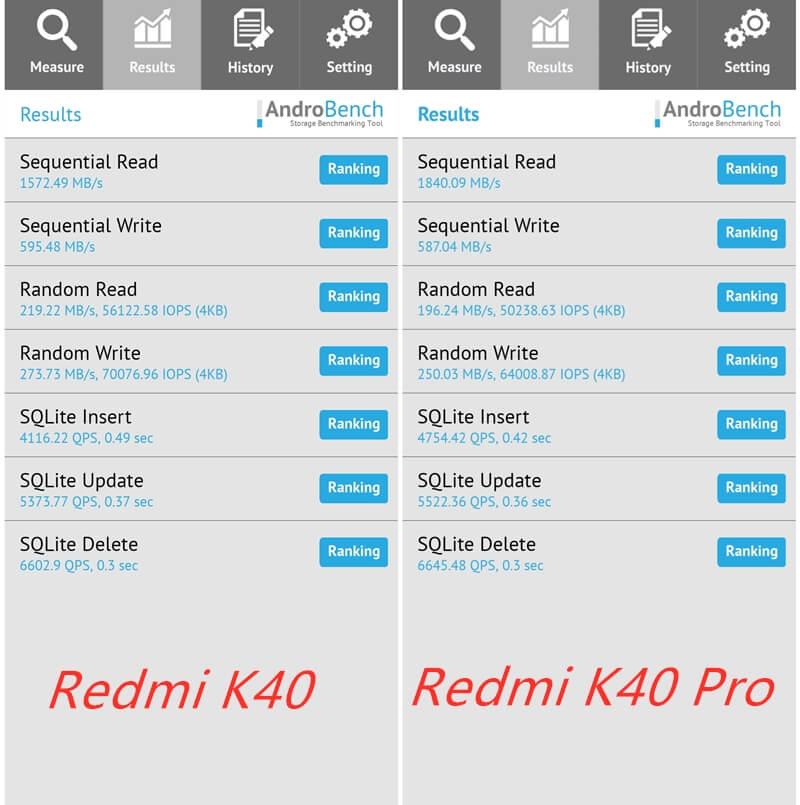
AnTuTu:Redmi K40's AnTuTu score exceeds most Snapdragon 865 models,In the Android camp, it is basically second only to Kirin 9000 and Snapdragon 888 models.。

Redmi K40 Pro's AnTuTu running score is at the top level of the Android camp,Comparable to 888 models such as Mi 11
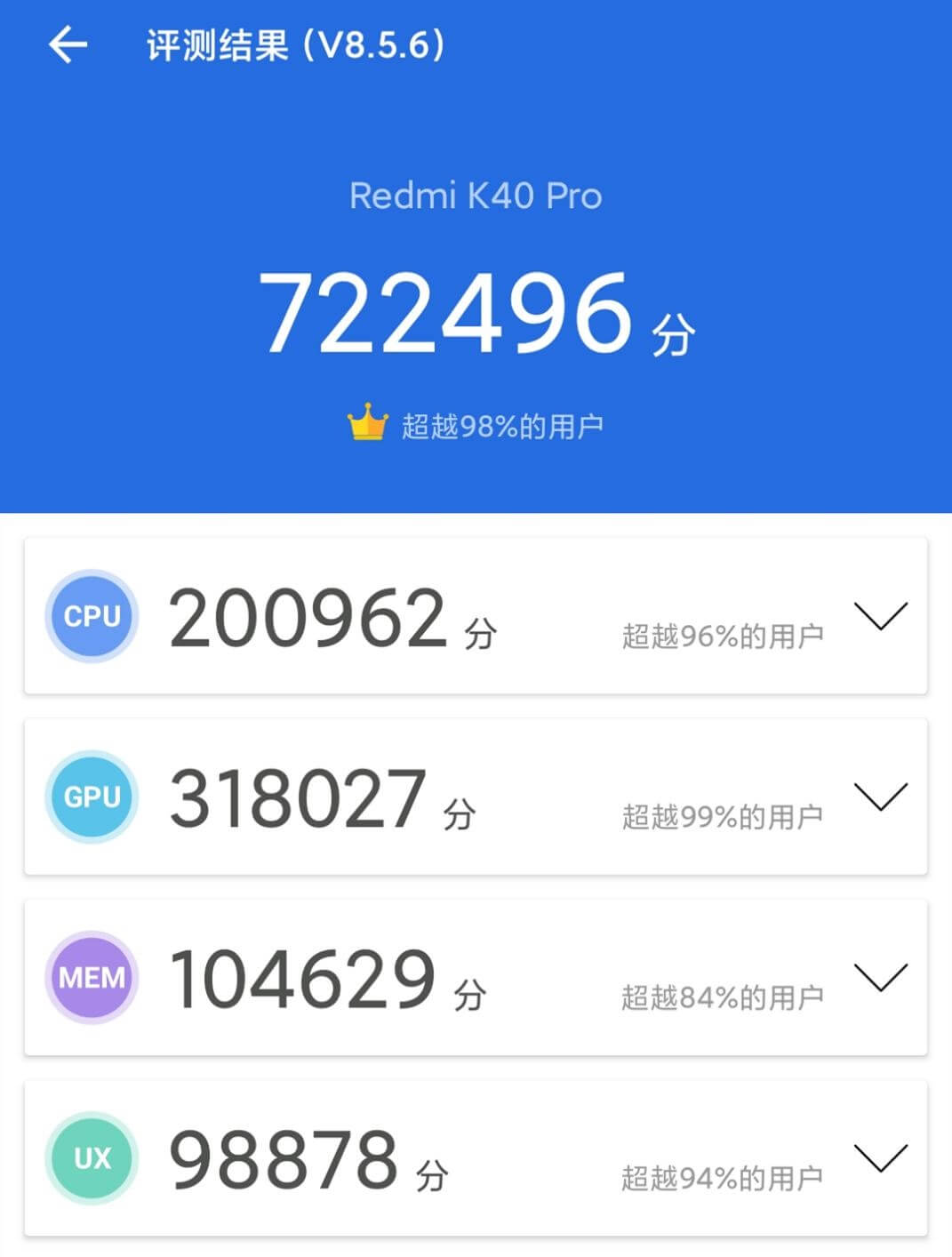
Nine、screen experience:120Hz E4 AMOLED puts heart and soul into it
If you must choose the most important "three major pieces" of the current smartphone,I'm afraid I can't escape the processor platform、Screen and Video Modules。In fact,From some analysts on the iPhone、Component analysis of Samsung and other flagship mobile phones found that,It is these three items that account for the bulk of the cost of BOM materials。
The Redmi K40 series is naturally indispensable to invest in the three major components,In addition to the processor we just tested and analyzed and the image performance we will talk about next,As the first big thing that catches the eye after opening the box and turning it on,This display is impressive from the first touch。
All Redmi K40 series use E4 AMOLED screen,6.67 inch straight screen design,regardless of brightness、Contrast,still color
allow、Color performance has reached the top level。Peak brightness 1300nit、Contrast,00,000:1、JNCD=0.36、△E=0.35。It is worth mentioning that,Redmi K40 Pro in the test of the authoritative screen testing agency DisplayMate,Received the highest rating of A+。
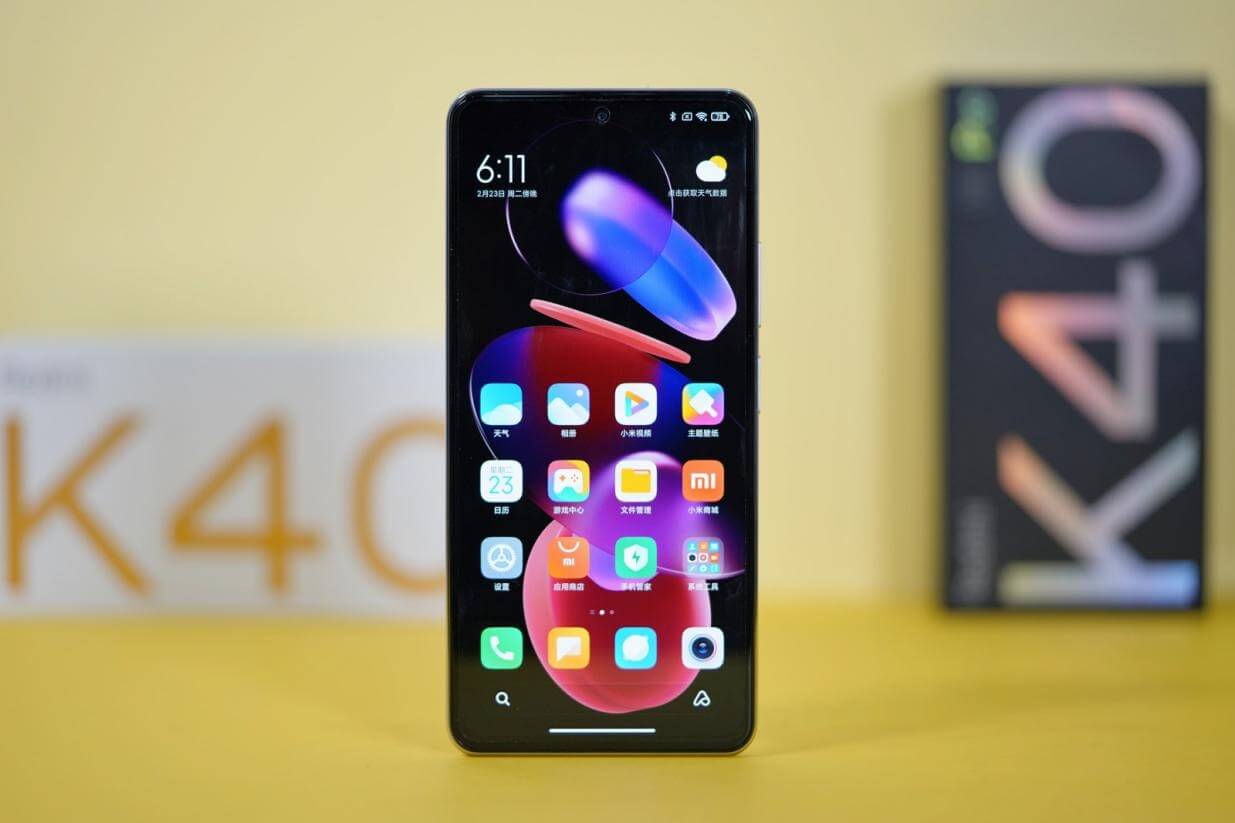
The screen refresh rate of the Redmi K40 series reaches 120Hz,Means more screens can be displayed at the same time,play in video、system operation、In games and other scenarios,Bring smoother picture performance。Simultaneously,K40 industry first 360Hz three-finger touch,Even higher than some well-known e-sports phones。
However, the quality of a mobile phone screen is not only determined by the above parameters,while watching the screen,We often have problems because the color temperature of the ambient light does not match the color temperature of the screen,Can cause eye fatigue over time。
The Redmi K40 series supports 360° front and rear dual light sensing,The integrated judgment of the front and rear light sources of the fuselage through the front and rear light sensors,Improve the recognition accuracy of ambient light,And support 8192 levels of brightness adjustment,Automatic smooth brightness adjustment。
It is worth mentioning that,Redmi K40 series built-in dedicated ambient light sensor,Ambient light color information can be detected through multiple internal optical channels,Compensate the color temperature of the screen according to different ambient light,Make the display color temperature more in line with the ambient color temperature,More comfortable。With 360° light perception,Accurate brightness and color temperature adjustment in different environments。

Here we use Mijia desk lamp 1s (2600K-5000K color temperature adjustment) to adjust the color temperature of ambient light,The color temperature adjustment of the Redmi K40 is checked,As follows,The effect is quite obvious。